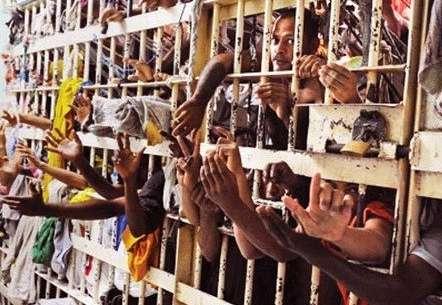COVID-19: Overcrowded Prisons Across Country a Cause for Concern

Representational Image. Image Courtesy: OrissaPost
While authorities have been beefing up the efforts to flatten the COVID-19 curve in India, many prisons across the country have become a concern as they are overburdened. Epidemiologists have already warned that things will spiral out of control if the virus starts spreading inside the jails.
"Indian prisons are infamous for being overcrowded. They have 17% more prisoners than their full capacity. They have males, females and children, who are born inside, mostly below the age of 5," Dr KK Aggarwal, cardiologist and president of the Heart Care Foundation of India, told India Today.
"Now at a time when social distancing is the key to breaking the chain of infections, this kind of overflowing occupancy in prisons is a matter of grave concern. Sanitation facilities in prisons are horrible. Learning from other countries who are in far worse conditions, prison authorities need to make sure that inmates maintain 6-foot distance," the report quoted him as saying.
According to Prison Statistics India (PSI) 2018, there are 1,339 jails across the country. As of December 31, 2018, there were 4,66,084 inmates in all jails across the country against the actual capacity of 3,96,223. The total occupancy rate stands at 117.6 which simply indicates that prisons have more than 17.6% inmates than authorised capacity. At a time, when health organisations mandate physical distancing to prevent the spread of COVID-19, such precautions become nearly impossible in such overcrowded jails.
Also watch: Let’s Talk: Threat of COVID-19 Infections in Jails and Threats to Media During the Pandemic
According to a report in Times of India on March 24, twenty prisoners in Uttar Pradesh’s Baghpat Jail were quarantined since they had symptoms of COVID-19. In Uttar Pradesh, the occupancy rate in jails is 176.5 which means the number of prisoners is 76.5% higher than the authorised capacity.
While, as per PSI report, few states including Punjab, Bihar, Assam, Rajsthan, Odisha, Andhra Pradesh, Telangana, Manipur, Goa, Tamil Nadu, Nagaland and Tripura have occupancy rates lower than 100%.
Meanwhile, on March 23 this year, Tihar Jail, the country’s largest prison, announced its plans to release on parole or interim bail some 3,000 inmates who are not “hardened criminals” following the directions of the Supreme Court of India.
On March 16, the Supreme Court of India had asked all the states and union territories to submit written replies on the steps being taken by the respective authorities to prevent the spread of the pandemic among the inmates in jails. The apex court also observed “a high risk of transmission of COVID-19 to prison inmates”, with prisoners, prison staff, families of prisoners and lawyers entering and leaving jails frequently.
The Supreme Court, however, on the same day praised the arrangements made in the jails across Kerala. The court in its observation said that Kerala has set up isolation cells within prisons across Kerala. Those suffering with COVID-19 symptoms are being moved to these isolation cells. All the new inmates who will be admitted to prisons will be kept under observation in these isolation rooms before permitting them to the regular prison cells.
The court also suggested that prisoners convicted of, or charged with, offences involving jail terms of seven years or less could be considered for parole or interim bail during the order on March 23.
Following the directions, the Delhi government told the Delhi High Court in response to a public interest litigation that the state would “amend rules to enable prisoners who had served a year of their sentence and undertrials who had been in jail for three months to avail of parole or furlough, in cases of specific offences.” The government issued a notification introducing a new provision of "Emergency Parole" of two months. As of March 30, as many as 409 prisoners have been released - 356 have been given interim bail, and 63 have come out on emergency parole.
Also read: COVID-19: Updated Graphs of Cases, Recoveries and Deaths
"Family mulaqat and all court productions have been stopped till March 31. Sensitisation of jail staff, as well as inmates about general hygiene and precautions regarding Coronavirus, is being done. Masks are being provided for staff and inmates. Hand wash and sanitisers are also being given," said, Sandeep Goel, Director General (Prisons), Delhi.
As per reports, Maharashtra, which has been one of the hardest hit states in the country, has proposed to release over 5,000 inmates and made the COVID-19 test mandatory for all new inmates. Twenty isolation cells have been set up in Mumbai’s Arthur Jail for prisoners with COVID-19 symptoms. The jail houses around 3,700 inmates against the capacity of less than 1,000.
While in Assam, as many as 722 under trial prisoners have been released as of March 31.
Not only are the jails overcrowded, there is also a shortage of medical personnel. Though the sanctioned strength of medical personnel in jails is 3,220, there are only 1,914 medical personnel posted, which is a 40% shortage.
Jails in India have average of one medical personnel for 243 inmates. In the case of Jharkhand, the ratio is the worst with 1,375 inmates per medical personnel. In West Bengal and Uttar Pradesh, the ratios are 923 and 737, respectively. The total expenditure on prison inmates in 2018-19 was Rs 1,776 crore. Of this, only 4% or Rs 76 crore was spent on medical needs. Clothing and welfare activities accounted for 1.4% each.
Get the latest reports & analysis with people's perspective on Protests, movements & deep analytical videos, discussions of the current affairs in your Telegram app. Subscribe to NewsClick's Telegram channel & get Real-Time updates on stories, as they get published on our website.
























